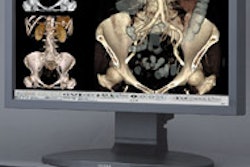The task of integrating electronic medical records and PACS networks can be made easier if both are Web-based applications -- and if there is a high level of cooperation between vendors -- according to researchers from Kaiser Permanente.
"Analyze and articulate the value early, and get the vendors to work together," said Richard "Skip" Kennedy, assistant director of radiology informatics for Kaiser Permanente, Northern California. He spoke during a talk at the annual meeting of the Society for Computer Applications in Radiology (SCAR) in June.
Kaiser performs 3.6 million imaging procedures in northern California each year. The nonprofit health plan is in the midst of a plan-wide IT initiative called HealthConnect, which includes a $3.6 billion EMR deployment being performed over 10 years.
The installation will allow doctors and staff to access the electronic health records of all 8.2 million Kaiser members, Kennedy said. As might be expected with a health plan the size of Kaiser, scalability is the principal challenge facing the project, thanks to a large number of Kaiser facilities, physicians, and even multiple PACS vendors.
Each Kaiser hospital has its own PACS network, which is joined with other networks by a large DICOM archive, Kennedy said. In the course of the project, Kaiser learned that integration should be performed from EMR to PACS, rather than from PACS to EMR.
"The EMR is the larger project, and PACS is the smaller project as we head forward," he said.
Kaiser's PACS project in northern California now also includes southern California facilities, to handle approximately 7 million radiology exams per year. All sites are linked via an archive, he said.
Given the widespread adoption of PACS, there was little interest in replacing those systems, Kennedy said. To integrate PACS with EMR, Kaiser then had to choose from integration approaches such as a traditional HL7/DICOM interface approach, Web integration, or a hybrid model, he said. The hybrid model turned out to be the winner.
End-user expectations
Users did not want two systems that were glued together retrospectively, but rather an approach that yielded a seamless user interface integration, Kennedy said. This includes a single login from the EMR, availability of patient/exam lists within the EMR, patient/exam state communication by the RIS to PACS and EMR jointly, and continued availability of the PACS user interface for use in radiology, he said.
For example, users could log in to the EMR, select the appropriate exam, and open the image report. After the link is clicked, the PACS viewer is launched.
The key to the PACS/EMR Web integration was defining the structure for the query URL and the native ability of the PACS to launch as a URL via an active server page, Kennedy said. Both the EMR and PACS audit access.
Kaiser credited the integration to the Web-based nature of the PACS and EMR applications, and having access to the application programming interface (API), Kennedy said in conclusion.
A high level of cooperation between vendors is required to facilitate this integration, Kennedy said. Kaiser's legacy RIS serves as the HL7 intermediary and authoritative source for all patient information.
By Erik L. Ridley
AuntMinnie.com staff writer
August 4, 2005
Related Reading
Diagnostic imaging and clinical information systems: An integration primer, April 14, 2005
EMR implementation benefits from prior workflow analysis, February 18, 2005
IHE assists regional health architecture, February 15, 2005
Copyright © 2005 AuntMinnie.com



















